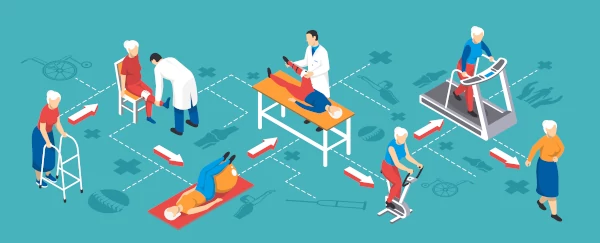As we age, our bodies go through a lot of wear and tear, and it’s not uncommon to experience physical pain and discomfort. This is where physiotherapy comes in. Physiotherapy is a form of treatment that focuses on the restoration, maintenance, and improvement of physical function and mobility. In this comprehensive guide, we will discuss the different aspects of physiotherapy treatment, its benefits, and how it can help you.
What is Physiotherapy?
Physiotherapy, also known as physical therapy, is a healthcare profession that focuses on the diagnosis, treatment, and prevention of physical impairments, disabilities, and pain. Physiotherapy can help people of all ages who have conditions that limit their ability to move and function. It uses a variety of techniques, including exercise, manual therapy, and electrotherapy to promote healing, reduce pain, and improve physical function.
What Conditions Can Physiotherapy Help With?
Physiotherapy can help with a wide range of conditions, including:
- Musculoskeletal Disorders: These include back pain, neck pain, joint pain, and arthritis.
- Neurological Disorders: These include stroke, multiple sclerosis, Parkinson’s disease, and spinal cord injuries.
- Cardiovascular Disorders: These include heart disease and stroke.
- Respiratory Disorders: These include chronic obstructive pulmonary disease (COPD) and asthma.
- Sports Injuries: These include sprains, strains, and fractures.
- Women’s Health Issues: These include pregnancy-related issues, pelvic floor dysfunction, and breast cancer.
- Pediatric Conditions: These include developmental delays, cerebral palsy, and spina bifida.
- Geriatric Conditions: These include improving the balance and coordination of older people to reduce the risk of falls and other accidents.
How does physiotherapy work?
Physiotherapy works by using a variety of techniques to help patients improve their movement and function. The specific techniques used will depend on the patient’s condition, but may include:
- Exercise therapy: This involves physical exercises that are designed to help patients improve their strength, flexibility, and endurance.
- Manual therapy: This involves hands-on techniques, such as joint mobilization, that are used to help patients reduce pain and improve their range of motion.
- Education and counseling: Physiotherapists work closely with patients to provide them with education and counseling on how to manage their condition, prevent further injury, and improve their overall health and well-being.
- Modalities: These are techniques such as heat, cold, and electrical stimulation that are used to reduce pain, inflammation, and muscle spasm.
- Dry needling: This involves the insertion of a thin, sterile needle into specific trigger points in the muscle, with the aim of releasing tension and alleviating pain.
- Cupping therapy: The suction created by the cups is said to help promote healing and reduce pain by increasing blood flow, loosening tight muscles, and releasing toxins from the body. Cupping therapy can be used to treat a range of conditions, including back pain, headaches, and respiratory issues.

What are the benefits of physiotherapy?
Physiotherapy can offer a wide range of benefits to patients, including:
- Improved mobility: Physiotherapy can help patients regain their mobility and independence, allowing them to perform everyday activities with greater ease.
- Pain relief: Physiotherapy can help reduce pain and discomfort caused by a wide range of conditions, including arthritis, back pain, and sports injuries.
- Improved balance and coordination: Physiotherapy can help patients improve their balance and coordination, reducing the risk of falls and other accidents.
- Preventing complications: Physiotherapy can help prevent complications that can occur as a result of a wide range of conditions, including strokes, heart attacks, and respiratory problems.
- Better overall health and well-being: By improving mobility, reducing pain, and preventing complications, physiotherapy can help patients improve their overall health and well-being.
What to Expect During a Physiotherapy Session?
During a physiotherapy session, you can expect the following:
- Assessment: Your physiotherapist will assess your condition and create a treatment plan based on your goals.
- Treatment: Your treatment plan may include exercise, manual therapy, electrotherapy, dry needling, and cupping therapy.
- Education: Your physiotherapist will educate you on your condition and how to manage it.
- Home Exercise Program: Your physiotherapist may prescribe exercises for you to do at home to help with your recovery.
- Follow-up: Your physiotherapist will schedule follow-up appointments to monitor your progress and adjust your treatment plan as needed.
Physiotherapy is an effective form of treatment that can help people with a wide range of conditions improve their mobility, reduce pain, and achieve a better quality of life. Whether you are recovering from an injury, managing a chronic condition, or simply looking to improve your physical function, a physiotherapist can help. With a range of techniques and interventions at their disposal, physiotherapists can create a personalized treatment plan tailored to your specific needs and goals. From manual therapies and exercise programs to dry needling and cupping therapy, physiotherapy offers a variety of approaches to promote healing, reduce pain, and improve function. With the guidance and support of a skilled physiotherapist, you can take an active role in your recovery and achieve optimal physical health and well-being. If you are interested in exploring the benefits of physiotherapy, talk to your healthcare provider or contact Healing First Physiotherapy clinic to learn more.


